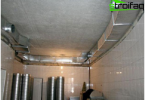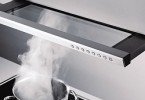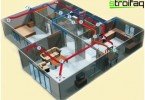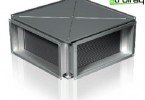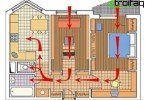The constant updating of indoor air creates comfortable conditions for the people in it, and is also necessary in order to maintain the construction of houses in good condition. When houses were heated with open fire, this problem was solved by itself – fresh air entered inside through the natural openings in the building. Today, in times of central heating, anti-draft equipment and high-quality thermal insulation, the ventilation system must solve the problem of fresh air entering the room.
Content
- Types of ventilation systems and methods for cleaning them
- We understand the equipment – what for what?
- Features of cleaning ventilation from fat
- Ventilation disinfection – the final and mandatory step
Types of ventilation systems and methods for cleaning them
The ventilation system is not very conspicuous, but nevertheless a necessary element of any building, both residential and industrial or warehouse. If you do not go into technical details, then the ventilation of the room can be divided into two types: natural and forced.
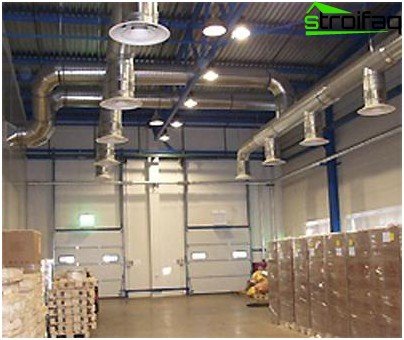
Maintaining the ventilation system in working condition will create a favorable microclimate in the room
Both natural and forced ventilation systems need periodic cleaning. There are also two approaches: the first, which is more to the liking of the Russian people, is to clean the ventilation as it gets dirty; the second, which has not yet become widespread due to the peculiarities of a national character, is periodic preventive cleaning of ventilation, regardless of its degree of contamination. The second approach, of course, is preferable in terms of the efficiency of the ventilation system and in terms of caring for the health of people who constantly use the room.
At first glance, it might seem that the ventilation system is operating normally, but over a long period of time, debris, dust, and various microorganisms have accumulated in it, which begin to circulate in the room along with air currents, thereby causing harm to humans. Moreover, untreated ventilation systems with garbage accumulated in them are considered a potential source of fire.
Cleaning ventilation systems today can be carried out in two ways: mechanical and chemical. The advantage of the mechanical method is its comparative safety both for people working indoors and for the system itself. However, mechanical means do not always manage to cope with serious contaminants, for example, in the case of a heavy load on the ventilation system or neglect of its cleaning standards. Then you should think about dry cleaning the ducts, most likely, it will give the expected result.
We understand the equipment – what for what?
For cleaning ventilation systems to be effective, use equipment specially designed for this purpose, which can be both professional and for widespread use..
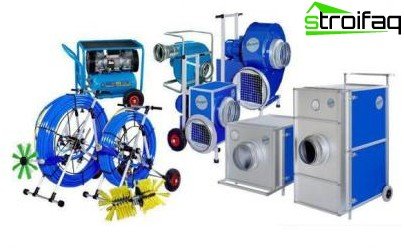
Equipment for cleaning ventilation consists not only of conventional brushes, but also of complex filtering devices
Typically, ventilation cleaning equipment includes brush sets for cleaning ventilation systems, mobile filter ventilation units and filters for them. A professional approach to the cleaning process also provides for a preliminary inspection of the system in order to identify the level of contamination and identify problem areas using special devices. In this case, equipment for cleaning the ventilation can be supplemented with such an unusual device as a video camera mounted on a moving platform of a small size, which transmits a signal directly from the ventilation system itself.
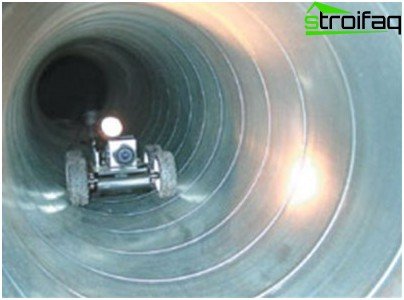
Using such professional devices, you can conduct a video inspection of ventilation and determine the degree of contamination
Features of cleaning ventilation from fat
In some cases, the natural ventilation system does not cope with the increased load, and more powerful forced ventilation has to be installed. This is especially true for rooms that are used for food processing or cooking: production halls or kitchens in houses and apartments. The ventilation installed here should eliminate excessive amounts of steam and odors of cooked food, but in the process it quickly becomes contaminated with fat, which, when mixed with dust, turns into an unpleasant substance that is difficult to remove.
In cases of slight contamination, the ventilation can be cleaned of grease using detergents and warm water; in more advanced cases, radical methods such as soaking the hood parts in a drain pipe cleaner can also be used. However, all this applies to external parts, for access to which it is not necessary to dismantle the ventilation system. In more complex cases, cleaning the ventilation of grease should be carried out by professionals in compliance with all norms and requirements.
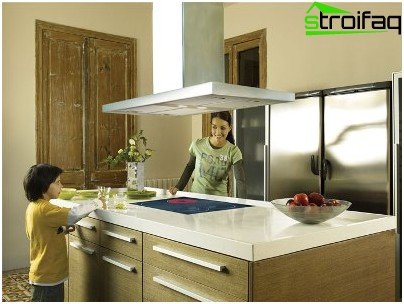
For the cooker hood to shine on the outside, the housewife’s efforts are enough, but professionals should be allowed to the internal elements.
Some cleaning options include dismantling the ventilation system, but cleaning the ventilation in the apartment does not need such harsh measures. With the simplest devices you can try clean the ventilation duct from the apartment to the main aircraft. Detected debris and dust in this area can be removed with a vacuum cleaner. It is not recommended to move further than your own ventilation, since the main ventilation course and its condition is the concern of the organization.
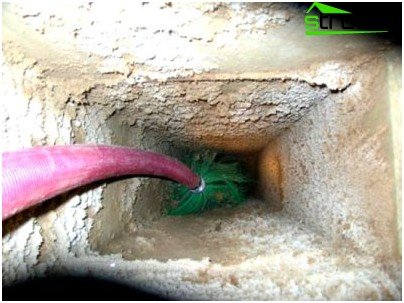
Cleaning the ventilation in the apartment can be done with the simplest appliances
Important! In the main duct, there may be not only dust and debris, but also less pleasant inhabitants like mice, rats, wasps and cockroaches. Be careful not to disturb them..
Ventilation disinfection – the final and mandatory step
The most common mistake is that ventilation cleaning usually ends at this point. The main motive is understandable and explainable – the desire to save money on disinfection of ventilation. However, experts argue that the cleaning and disinfection of ventilation systems should be a set of measures and must complement each other. If cleaning saves the ventilation system of contaminants and deposits, then disinfection is responsible for microbiological safety. Dust mites, viruses transmitted by airborne droplets, bacteria and fungi can easily withstand mechanical and even chemical cleaning, and only treating the inner surface of the ducts with a disinfectant solution will relieve them of their unpleasant neighborhood.


